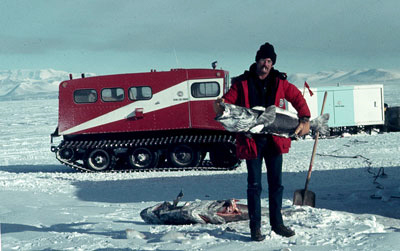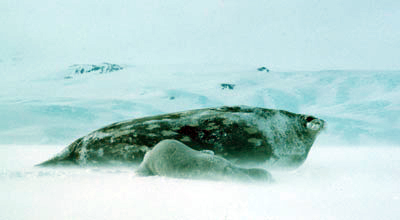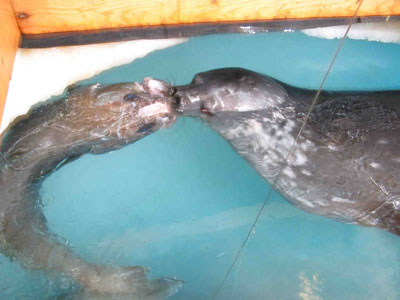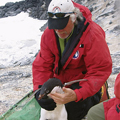Weddell Seals in Erebus Bay
Today we conducted an aerial survey of Weddell seals in Erebus Bay. Our project doesn’t usually spend much time observing seals, other than leopard seals that prey on penguins, but last summer we submitted a protocol about counting seals to the folks who control industrial fishing in the Southern Ocean. That organization is called, in somewhat of a euphemism: Commission for the Conservation of Antarctic Marine Living Resources (CCAMLR). They are chartered, through the Antarctic Treaty, to make sure that fishing does not irreparably harm the Antarctic ecosystem.
About 10 years ago New Zealand decided that the Antarctic toothfish, known to the rest of the world as Chilean sea bass, should be extracted from the Ross Sea. It’s the last place left on Earth where the ocean fish have not been depleted. After five years of “experimental fishing” by NZ, a full-fledged fishery was launched. This now includes about a dozen countries and 21 fishing vessels. Despite their charter to protect the living resources of Antarctica’s seas, CCAMLR instituted no procedures for monitoring the impact of the fishery on the ecosystem. So we’ve taken it upon ourselves to come up with some procedures by which this can be done.

Adult Chilean sea bass (on snow) and subadult (held by person) caught through a hole in the fast ice of McMurdo Sound.

Antarctic silverfish, which both Chilean sea bass and Weddell seals eat in the Ross Sea.
Weddell seals eat a lot of toothfish and the best-known population of these seals, and perhaps the best-studied pinnipeds population in the World, is in southern McMurdo Sound, in the vicinity of Cape Royds. Thus, with the seal folks from Montana State University, we submitted a procedure to CCAMLR last summer to monitor the seal population using aerial photography. The idea is that as more Chilean sea bass are taken from the Ross Sea, the seal population should change. Seal numbers would either decline because there are fewer sea bass to eat or increase because with fewer sea bass there would be more silverfish for the seals to eat (the fish and the seals also compete for Antarctic silverfish).

Weddell seal mom and pup, Erebus Bay, McMurdo Sound

Weddell seal with toothfish (Chilean sea bass) that it captured, and which it is beginning to consume.
CCAMLR accepted our aerial protocol but then told us we had to demonstrate its utility in the field. This led to our aerial flight. To say the least, with aerial photography having been used to count seals in the Arctic for decades, our counts from the air were close in number to those counted on foot two days previously. We’ll now submit a report to CCAMLR and hopefully the fishing industry will take the responsibility to begin at least one measure to keep track on how their fishing may affect the ecosystem of the Ross Sea.

Weddell seals spread along a tide crack in Erebus Bay; view from 1000 ft.










I recently read on the web about how the U.S. Geological Survey has been studying the Deuterium/Hydrogen ratio in bird feathers among various bird populations both migratory and non-migratory. They published a map that shows a variance of D/H with latitude. I would like to see how polar birds fit into such a profile. Also, perhaps there are historical trends.
Thank you, for your stories. I would like to know what a toothfish is. I thought the toothfish was a seal it was so big. Your job must be fun. I will be watching a telecast tomorrow from Cody, Wyoming. I look forward to hearing from you.
Sincerely,
Laural Lawler 4th Grd.
Valley School
Cody, WY
Hi Laural– I hope you’ve enjoyed our webcasts. Great to know that you’ve been following us in Antarctica from Wyoming. Have you been talking about this project in your classroom?
In answer to your toothfish question, you are in luck: another Ice Stories correspondent just arrived in Antarctica to study toothfishes specifically! I’m sure she’ll be posting some very interesting dispatches that will allow you to learn a lot about the toothfish. In the meantime, I’ll tell you a little bit about them. These fish are pretty remarkable. Their natural life span is up to 50 years, and they can grow to weigh 300 pounds. The most amazing feature, though, is the way they’ve adapted to their environment. The waters in the Southern Ocean are the coldest waters on Earth– and if you put almost any other kind of fish in there, it would freeze to death very quickly. The toothfish, however, evolved a way around that. It produces a protein that acts like antifreeze. This antifreeze runs in the toothfishes’ veins to prevent its blood from freezing. It’s a great example of the remarkable ways that living creatures evolve to adapt to their own environment.
please can you help me on my homework, i need to know what the climate is like there, the scenery, sea and land resources and finally greenpeace!?
pleeease help me as it needs to be done and i cant find it on the internet!